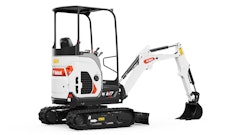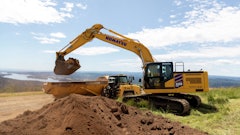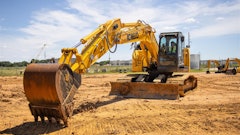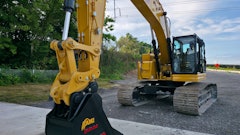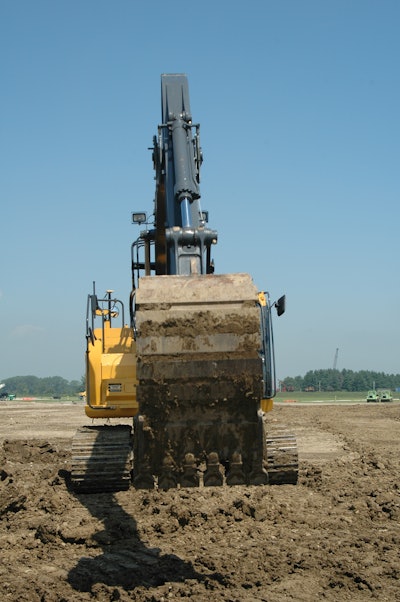
Proper operation of an excavator while trenching, sloping or benching can have a big impact on productivity. Planning ahead will optimize performance, minimize the risk of accidents and maximize productivity.
One of the most common mistakes is failing to plan your approach to the excavation. Bottlenecks in the process can result in moving material more times than necessary. Take time to visualize how the job will progress to avoid "boxing" the machine in between obstacles or the spoils pile, or limiting your reach.
- As part of the planning process, it’s important to identify:
- where you will put the spoil pile
- where pipe, bedding or other materials will be staged
- where any existing utilities are located
- and, in the case of trenching, whether additional shoring may be needed.
A stable platform for the excavator is an essential element of site setup. Make sure the machine will sit on even ground and that the ground is stable. If needed, pack dirt under one of the tracks to ensure a level surface.
When digging a trench, take time to create some form of guide, whether that be offset stakes, a chalk line or stringline. Then align the front and back of the machine to the line you’re referencing to ensure you’re tracking straight.
Training Tips for Safe, Efficient Trenching
Position the machine at a productive height for loading material. The bench height should be about the height of the haul vehicle’s sideboards. Most experts recommend setting up for the trucks to come down the left side of the excavator, which is best for loading angle and visibility.
Safety First
 A stable platform is an essential element of site setup. Make sure the machine will sit on even ground and that the ground is stable.
A stable platform is an essential element of site setup. Make sure the machine will sit on even ground and that the ground is stable.
Make sure you know the type of soil on which the excavator is resting, and ensure the machine is positioned far enough back to support its weight.
Maintain awareness of people and objects around the machine at all times. Be aware of blindspots around the machine, including the working radius of the rear counterweight. Built-in camera systems on today’s excavators can help to mitigate risks, but it is still the operator’s responsibility to be aware of objects, equipment and especially personnel within the work area.
Pay close attention to the direction of travel. An excavator allows the upper housing to be rotated 360 degrees. However, the undercarriage tracks in the same direction, regardless of which way the operator is facing. Make sure that you are in the forward-facing direction to avoid inadvertent movement in the wrong direction that could potentially put the operator and machine – as well as those working around it – in a precarious position.
Raise Excavating Safety to New Heights
Get Productive
Once you're ready to dig, start with a marking path for the top layer and gradually work your way down. Avoid digging from the bottom up, which can waste time and fuel and lead to under cutting the excavator.
Completing a series of short, connecting sections is more efficient than digging a series of holes and trying to connect the holes. Start out by digging the teeth in just enough to mark the direction of the trench so it's in alignment. Then, gradually go down layer by layer.
A grade laser or other form of grade control system can make the task of achieving grade much easier. However, it’s important to calibrate the system with the position of the bucket prior to beginning excavation.
Simplified Grade Control Promises Rapid Returns
If the project requires working on the face of a hill, it's important to consult the equipment operator's manual to determine the safe operating ratios.
Position the tracks of the excavator straight up and down the hill. Should the machine start to slide, it will be at less risk of tipover should the edge of the tracks catch on something on the way down. Also position the sprockets, which are the heaviest part of the track, inside so they’re next to the hill.
The steeper the slope, the more care required. The more extreme the slope, the harder the swing motor will be required to work. If you’re moving material too quickly, it may not be able to safely handle the load. In such cases, slow, steady movement is actually more productive, or smaller bucket loads, may be more productive.
Productivity can be enhanced by taking advantage of an excavator’s operating modes, e.g., fine grading mode. These automatic settings optimize both the speed of the engine and hydraulic settings to the task at hand.
In-cab Controls Enable "Smart” Excavator Technology
Resources: John Deere, Liebherr, VISTA Training



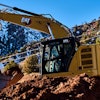
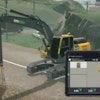
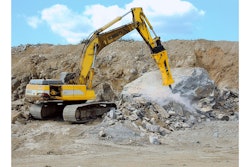
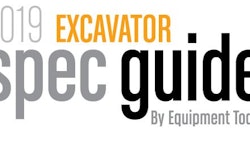
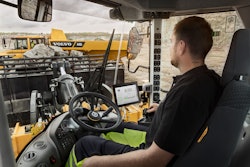






![Hcm Ax Landcros Dual Branded Logo[25]](https://img.forconstructionpros.com/mindful/acbm/workspaces/default/uploads/2025/11/hcmaxlandcros-dual-branded-logo25.Qhg3vUCjoK.jpg?ar=16%3A9&auto=format%2Ccompress&bg=fff&fill-color=fff&fit=fill&h=135&q=70&w=240)
